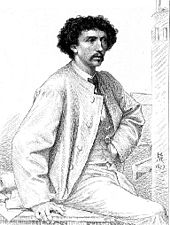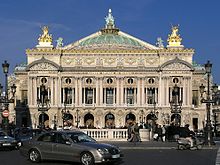Charles Garnier
Charles Garnier (full name Charles Jean Louis Garnier , born November 6, 1825 in Paris , † August 3, 1898 in Paris) was a French architect of historicism and architectural writer . His best-known work is the Opéra Garnier (also “ Palais Garnier ”) named after him , the venue of the Paris Opera .
Life
Garnier came from a humble background. In Paris he first attended the drawing school and began studying architecture at the École des Beaux-Arts from 1842 . He then worked as a draftsman for one of the most famous and influential French architects of his time, Eugène Viollet-le-Duc . Garnier won the Prix de Rome in 1848 and lived in Rome from 1849 to 1854, as well as touring Greece and Turkey.
In 1858 Garnier married Louise Bary (1836–1919) and the couple had two children, Daniel (1862–1864) and Christian (1872–1898).
Back in Paris, the young and largely unknown architect surprisingly won the architecture competition for the construction of the new Paris Opera in 1860. He was even able to assert himself against his former teacher Viollet-le-Duc and secure one of the largest construction contracts in Paris in the 19th century. After 15 years of construction, his opera house was rebuilt in the new Napoleon III style in 1875 . completed. The work on the opera would not let him go until the end of his life.
Other important buildings by Garnier are the Panorama Marigny (1880/1882, Théâtre Marigny since 1894 ) in Paris, the concert hall of the Casino of Monte Carlo (1878/1879), the Opéra de Monaco and - in collaboration with Gustave Eiffel - the Observatoire de Nice (1880–1892) and his villa in Bordighera in the Italian style .
In 1874, shortly before the completion of construction work on the opera, the Institut de France Garnier awarded a seat in Section III (Architecture) of the French Académie des Beaux-Arts . His grave is in the Montparnasse cemetery in Paris .
Fonts (selection)
- A Travers les Arts. Causeries et mélanges . Paris 1869 ( Internet Archive ) (collected writings and reflections)
- Le Théâtre , Paris 1871 ( Internet Archive ) (on the construction and use of theaters)
- Histoire du Nouvelle Opéra de Paris . 2 volumes, Paris 1881 ( BNF )
- Temple de Jupiter Panhellénien à Egine ( restoration of the monuments antiques par les architectes pensionnaires de l'Académie de France à Rome ). Firmin-Didot, Paris 1884 ( HEIDI )
- with Auguste Ammann : L'Habitation humaine . Hachette, Paris 1891
literature
- Jean-Michel Leniaud: Charles Garnier. Éditions du patrimoine, Paris 2003, ISBN 2-85822-705-5 .
- Massimiliano Savorra: Charles Garnier in Italia. Un viaggio attraverso le arti. 1848-1854 . Il Poligrafo, Padua 2003, ISBN 88-7115-349-9 .
- Bruno Girveau (Ed.): Charles Garnier. Un architecte pour un empire exposition présentée à l'École Nationale Supérieure des Beaux-arts, Paris, from October 26th 2010 to January 9th 2011. Beaux-arts de Paris les Éditions, Paris 2010, ISBN 978-2-84056-342-6 .
Web links
- Literature by and about Charles Garnier in the catalog of the German National Library
Individual evidence
- ↑ Wolf Stadler et al. a .: Lexicon of Art 5th Gal - Mr. Karl Müller Verlag, Erlangen 1994, ISBN 3-86070-452-4 , p. 13.
- ^ Bernard Comment: The Panorama , Reaction Books, London, 2003, p. 68
| personal data | |
|---|---|
| SURNAME | Garnier, Charles |
| ALTERNATIVE NAMES | Garnier, Charles Jean Louis |
| BRIEF DESCRIPTION | French architect |
| DATE OF BIRTH | November 6, 1825 |
| PLACE OF BIRTH | Paris |
| DATE OF DEATH | August 3, 1898 |
| Place of death | Paris |


